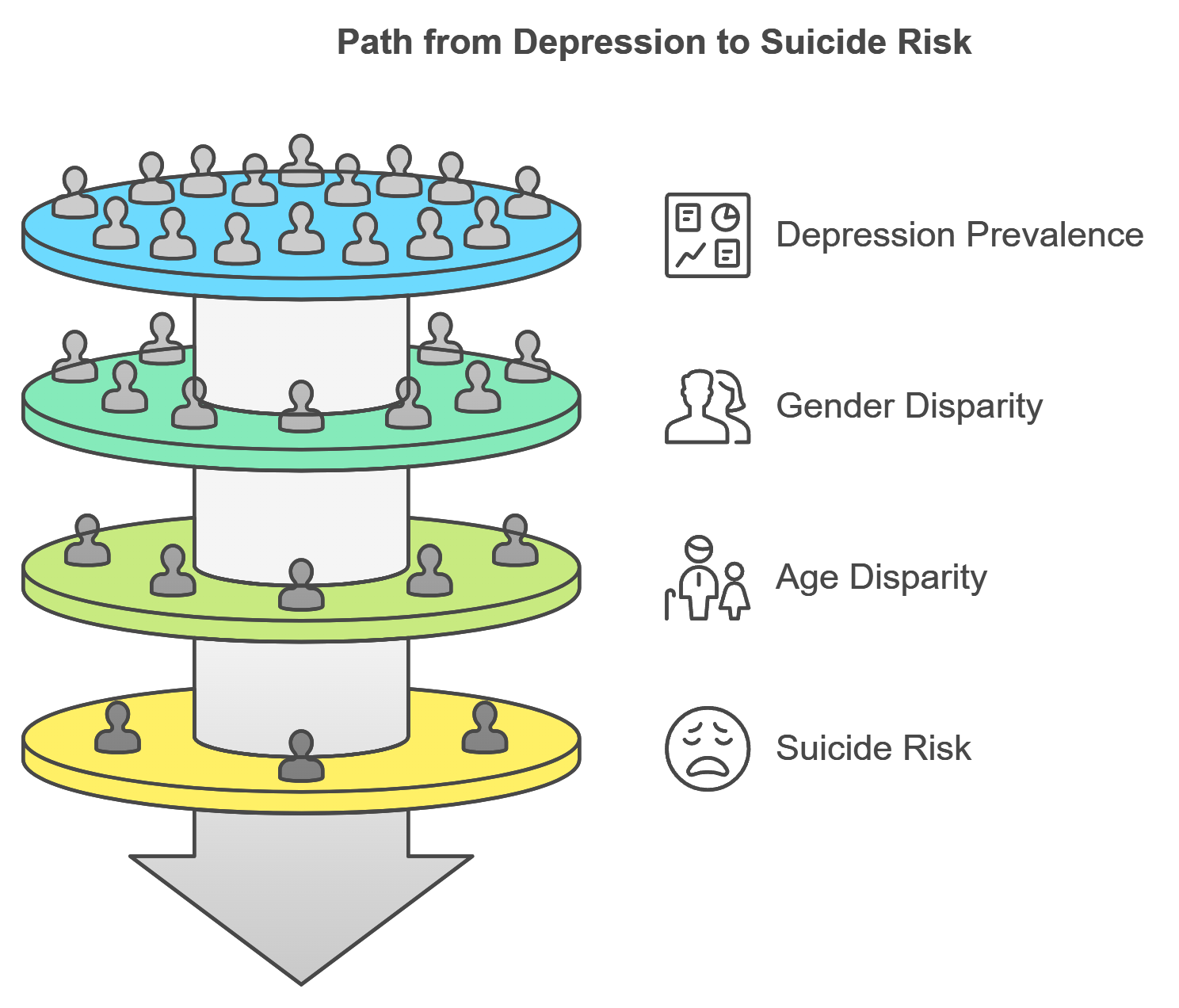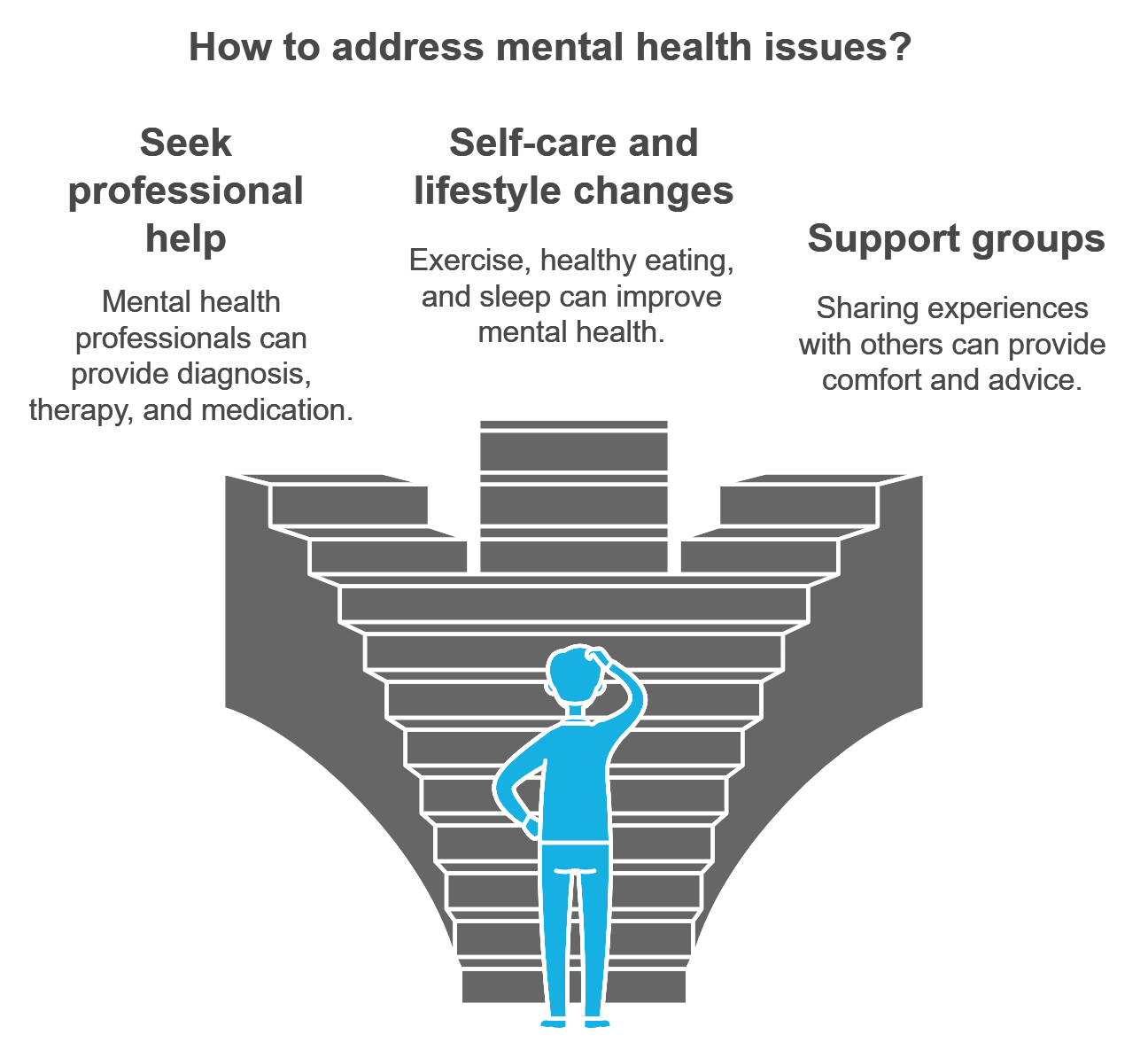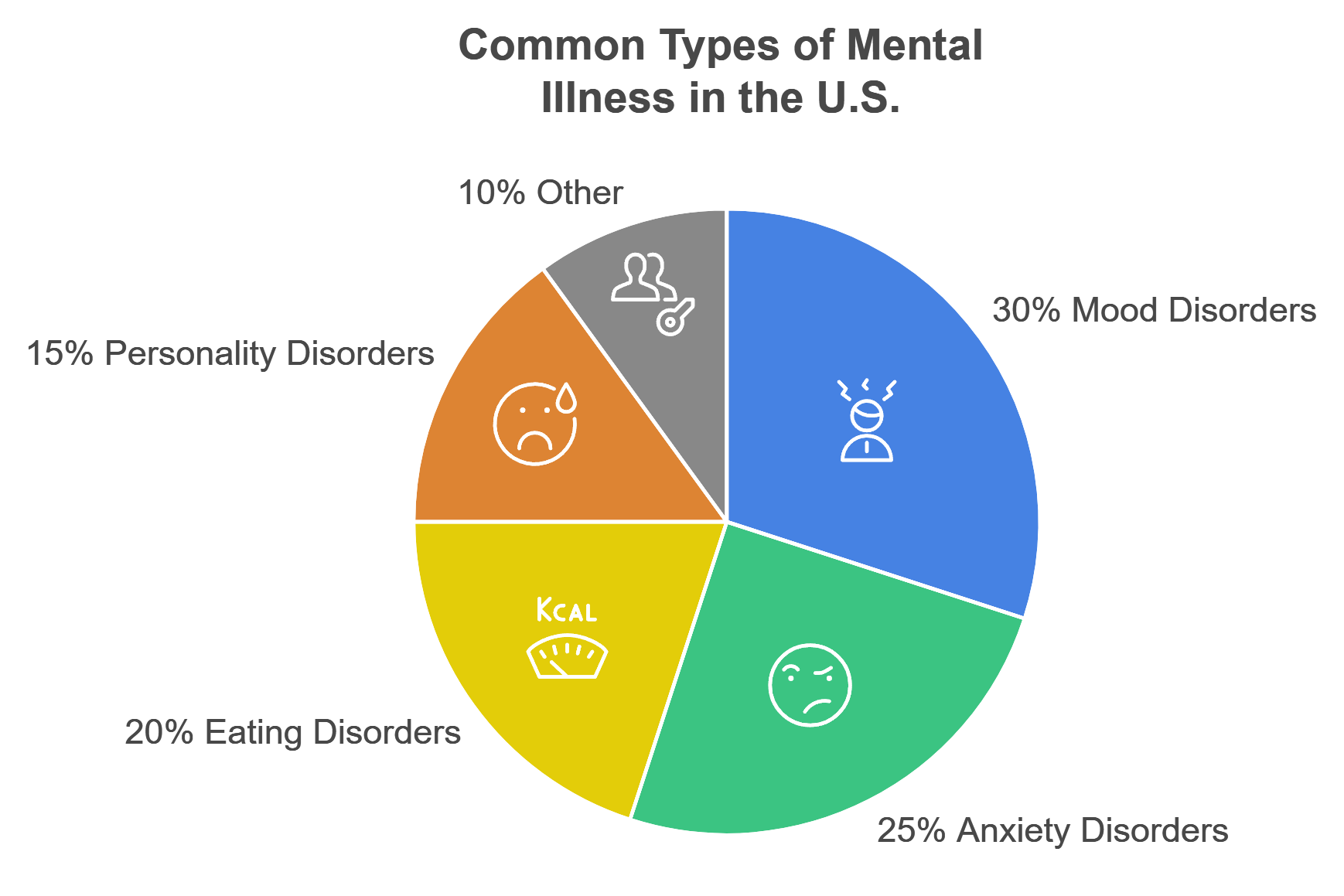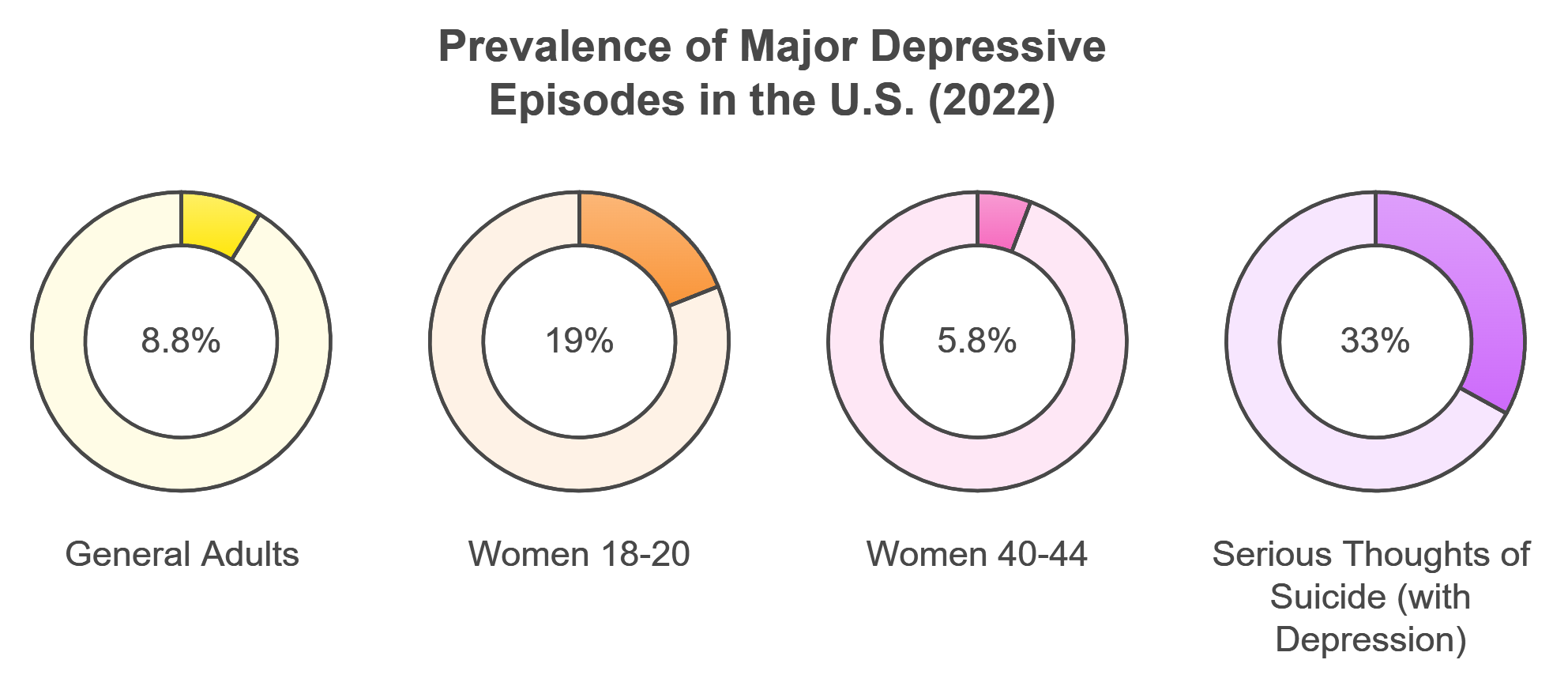U.S. Mental Health Issues - Statistics and Facts
- 04 Nov, 2024

The United States and many other countries have people suffering from psychological disorders. The 2022 Behavioral Health Barometer indicates that more than one in five American adults suffers from mental illness, bringing the total number of affected individuals to 59.3 million and making up 23.1 percent of the American adult population.
Various conditions which constitute these illnesses can range from mild to severe depending on the person’s circumstance. These conditions can be categorized into the following two broad groups: Any Mental Illness (AMI) and Serious Mental Illness (SMI). AMI implies all the types of mental illnesses that are acknowledged and SMI is described as a small more severe subcategory of AMI.
 Mental Health America (MHA) works toward the prevention of illnesses and advancement of health, focusing on the key aspects of welfare. This organization believes that there will emerge a time when mental health equity would be the norm and all individuals and communities would possess the ability to find purpose and meaning in life. Such organization aims to collect and disseminate up to date information for the purpose of drawing attention to the challenges that people with mental health conditions face.
Mental Health America (MHA) works toward the prevention of illnesses and advancement of health, focusing on the key aspects of welfare. This organization believes that there will emerge a time when mental health equity would be the norm and all individuals and communities would possess the ability to find purpose and meaning in life. Such organization aims to collect and disseminate up to date information for the purpose of drawing attention to the challenges that people with mental health conditions face.
Recent statistics show that 22.8% or 57.8 million populations above the age of eighteen were having some kind of mental illness in the year 2021, while there are about 14.1 million people and this figure speaks to 5.5% of the populations suffering from severe mental illness. There is also a cut across the youth as young as 6-17 years olds have 16.5% of them said to have a mental health disorder as per the statistics provided in 2016. 7.6 % of the adult population are reported to have substance abuse and mental illness in the year 2021.
She reported that there are variances across the various communities regarding mental illness with the highest level being observed among the Non-Hispanic American India or Alaska native standing at 26.6 % followed by the Non-Hispanic Whites at 23.9%.
In line with the report released by Health National Interview surveys, 12.5% of respondents within the variables of eighteen years and older always experience feelings of strain, anxiety and worry. Psychiatrists in the United States also list depression as one of the usual illnesses affecting five percent of the total adult population.
A total of 57.2 million patient visits were attributed to mental disorders as the primary diagnosis during visits to physician offices in the United States of America in the year 2019. When it comes to emergency room units, mental, behavior, and developmental disorders saw higher statistics with 5.8 millions visits recorded in the year 2021.
The figures reported concerning the number of suicide deaths stood at 49,476 deaths which are a very worrying trend on the mortality rates in relation to mental health issues.

MHA has prepared the annual State of Mental Health in America report, which ranks all 50 states and the District of Columbia relative to mental health access and prevalence measures. Massachusetts, Connecticut, and Maine were the highest ranked states, while Nevada, Arizona, and Montana were ranked as the states that needed the most improvement in the 2022 report. The findings are presented in a comprehensive narrative summary, highlighting key trends, challenges, and areas for improvement across the nation.
Common Mental Health Problems
These data reiterate that a substantial proportion of the adult population in the US suffers from some form of mental illness. A total of 57.8 million adults (22.8 percent) had a mental illness in the year 2021. It is significant to note that 5.5%, i.e., about 14.1 million adults were diagnosed of serious mental illness.
These illnesses extend to adolescents, among whom fifteen percent (16.5 percent) of children between the ages of six and seventeen (6-17 years) respectively were suffering from mental disorders, which is roughly 7.7 million youth. Co-occurring mental health and substance use disorders also report significant statistics, which in 2021 stood at 7.6% of American adults, meaning that 19.4 million adults had both these Disorders.

Certain groups of adults are at greater risk of suffering from mental illness than others. Non hazardous Asians recorded a rate of 16.4%. An even bigger number was recorded among non hazardous Native Hawaiian or Other Pacific Islander people where 18.1% had a life time diagnosis. Non-Hispanic blacks recorded about 21.4% while hispanics and Latinos were 20.7% and non-hispanic white 23.9%, non-hispanic American Indian or Alaska native had the highest at 26.6%.
From 2019 to 2021, the proportion of adults aged 18-44 who had any mental health services increased irrespective of their place of residence. Both females and males in this age bracket had a higher likelihood of having sought treatment for mental health issues in the year 2021 compared to the situation in 2019.
Of all adults studied, 19.86 per cent are today considered to have a mental illness, that is nearly 50 million Americans, whereas 4.91 per cent are suffering from severe forms of mental illness. Furthermore, 7.74 percent of all American adults reported suffering from a substance use disorder in the preceding year including 2.97 percent who suffered from a disorder related to use of illegal drugs and 5.71 percent who suffered from alcohol use disorder.
Mental health disorders are also debilitating for healthcare systems. For example in 2019, there were 57.2 million office visits AIP (American Institute for Psychiatry) to physician’s offices wherein the main diagnosis was a mental disorder. Reports assessing emergency department chart reviews demonstrated a rough figure of about 5.8 million emergency department visits in the United States with primary diagnoses of mental 8418, behavioral, and neurodevelopmental disorders in 2021. Some major about mental health issues are also suicide, seen in the reports of about 49,476 suicide death casualties.
Recent Statistics
In 2022, the U.S. Mental Illness Statistics report indicated that 23.1% or approximately 59.3 million American adults were mentally ill. Among young people, 20.17% of those aged 12-17 years experienced a MDE at some point in the past year.

One of the disturbing findings is that among adults, there are concerns over mental health issues, with 12.5% of Americans said to be suffering from anxiousness on most days, 5.0% reporting the feeling on most days. It has been said that 57.2 million offices (in 2019) visitations had mental disorders as the main reason for the visit. In 2021, 5.8 million emergency visits were made due to mental, behavioral, and neurodevelopmental problems. The country has incurred losses of around thousands of suicide deaths as a result of untreated mental illness.

Furthermore, entrenched differences in access to treatment highlight the fact that there is an increasing demand for mental health services. In point of fact, out of all the states, Massachusetts, Connecticut, Maine, and others offered the most accessible mental health care, while Nevada, Arizona, and Montana had ones showing the greatest need for improvement.
Funding and Resource Allocation
Current Federal Funding for Mental Health Programs (2023)
In the year 2022 the America Congress administered astounding policies in collaboration with the Biden administration’s programs for American citizens for behavioral health care services which were regarded as the largest investment since the mental health policies commenced in the year 1960.
The purpose of this particular federal activity is to increase the outreach of the psychiatric assistance program to schools, workplaces, as well as communities, along with enhancing the delivery systems for behavioral healthcare. The additional funding provided in the 2022 budget is likely to be utilized in a variety of federal agencies responsible for implementing policies which focus on the mental health of the people of America which have been long overdue in the addressal.
The US Department of Health and Human Services and more particularly the Substance Abuse and Mental Health Services Administration (SAMHSA) allocated 36.9 Million dollars towards behavioral health services supporting Grant awarded programs. These Grants support the overarching goals of the Biden-Harris Administration to address the overdose and mental health crises and the existing disparities in health within the country. HHS Secretary Xavier Becerra more or less pointed to the support in providing communities which have been impacted by the needs of mental health and substance abuse with the relevant resources.
A new program undertaken by the HHS, working together with SAMHSA and the Office of Minority Health, has come to light that will allow the U.S. to spend nearly $35 million for enhancement and expansion of community mental health services and suicide prevention programs targeted at children and young adults. This program derives its support from $9.2 million allocated in the American Rescue Plan and is one of the many initiatives by the Administration to respond to mental health issues in the country.
In this regard, the National Institute of Mental Health (NIMH), which is the United States’ federal agency in charge of mental illnesses research, has a central part to play. The particular focus of The NIMH mission is directed to the unfathomable increase of knowledge and improvement of existing general and clinical therapies of mental disorders with further prevention, rehabilitation and eradication. There are several detailed rationales and allocations related to the initiatives of NIMH within the FY 2023 budget that reaffirms strong support from the federal government towards addressing mental health challenges in the country.
State Funding for Mental Disorders in America (2023)
The states have been ranked on the basis of general mental illness and care accessibility for both the adult and the youth population. The rankings of 1-13 indicate decreased prevalence of mental illness and improved chances of seeking help whereas the rankings of 39-51 indicate higher prevalence of mental illness and decreased chances of seeking help.
The ranking for adults is based on fourteen indicators as follows: number of adults reporting any mental disorder, alcohol or drug abuse, actively suicidal ideation, AMI that has never been treated, those with an AMI who have a statutorily defined need but do not receive any treatment, AMI patients who do not hold health cover, and those who report having experienced a number of days with mental ill health and haven’t attended a health care professional due to a lack of finances.
In 2023, federal funding has significantly impacted mental health services. Nearly $300 million was awarded in September for both new and existing Certified Community Behavioral Health Clinics (CCBHCs). An additional $15 million in new grants is scheduled to be awarded early next year under the Bipartisan Safer Communities Act. This legislation, spearheaded by Senators Stabenow and Blunt, aims to transform mental health and addiction services across the country by establishing CCBHCs, which provide comprehensive behavioral health services.
References:
- https://www.nimh.nih.gov/health/statistics/mental-illness
- https://www.cdc.gov/nchs/fastats/mental-health.htm
- https://www.cdc.gov/nchs/products/databriefs/db444.htm
- https://www.cdc.gov/nchs/fastats/mental-health.htm
- https://rollcall.com/2024/10/21/for-harris-mental-health-access-a-key-policy-priority/


